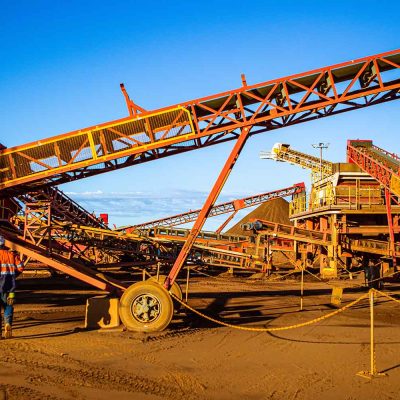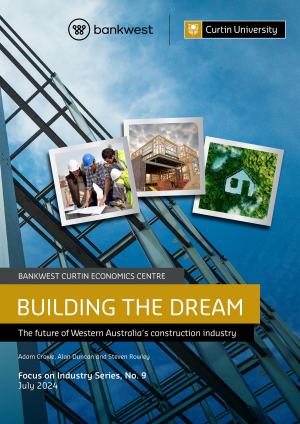Construction sector kickstart: calls for action on workforce, housing supply and sustainability to revive struggling industry

— High costs, labour shortages and demand putting pressure on the sector —
— Up to 1.4 million spare bedrooms in WA highlights failure to use housing stock efficiently —
— Calls for more ‘green’ construction, measures to attract workers and greater housing diversity —
A new report by the Bankwest Curtin Economics Centre has found that at current rates of dwelling completion, Western Australia will fall well short of the National Accord target of 25,000 new dwelling units per year – a figure which will only just keep pace with the state’s projected population growth.
Released today, the ‘Building the Dream: The future of Western Australia’s construction industry’ report finds the sector is facing significant challenges such as a severe shortage of skilled workers, fluctuating dwelling approvals and high material costs, with each contributing to ongoing issues in the sector and a failure of supply to meet unprecedented levels of housing demand.
However, should these issues be addressed, the sector has the potential to contribute significantly to the state’s economic, social and environmental progress.
Report co-author and Director of the Bankwest Curtin Economics Centre Professor Alan Duncan said the construction sector’s workforce shortage needed to be addressed through subsidies, incentives and competitive relocation packages. Accelerating the qualification process for overseas workers and providing hiring subsidies for new apprenticeships would also help fill critical gaps.
“Resources should be directed towards trades in highest demand and the Construction Training Fund program should be expanded to prioritise these areas,” Professor Duncan said.
The report also found that if every spare bedroom across the state was added together, it would amount to 1.45 million bedrooms across WA. Even if every dwelling with at least one unused bedroom were to use one of those rooms for another purpose, that leaves 675,000 spare bedrooms as vacant capacity.
“The extraordinary rate of vacant housing capacity points to two major issues in Western Australian housing,” Professor Duncan said.
“The first is that we are failing to use our current housing stock efficiently, and the second is that the diversity of housing stock remains inadequate.
“Improving the diversity of available housing options in WA and reducing transactions costs from stamp duty will encourage more ‘rightsizing’ among homeowners, which will release vacant housing capacity and improve the efficiency with which WA’s current dwelling stock is being used.”
The report also shows the high attrition of WA’s construction sector workforce to other industries, particularly the resources and manufacturing sectors, and to other states, particularly Queensland.
“Retaining skilled workers and new trainees is especially challenging for WA’s building and construction industry given the lure of other industry sectors, and this is why relocation and apprenticeship packages need to be designed to incentivise retention and prevent skills leakage,” Professor Duncan said.
“Contracting practices need improvement to protect both consumers and builders, and the government should pilot new contracting approaches for public projects and invest in off-site and modular construction to diversify housing options.”
Report co-author Dr Adam Crowe from the Curtin-AHURI Research Centre at Curtin University said the construction sector has an important role to play in WA’s net zero transition through the sustainability of its practices, and the progressive reduction of its carbon emissions.
“The environmental performance of WA’s construction industry over time has seen a steady and consistent decline in aggregate carbon emissions since 2007,” Dr Crowe said.
The report highlights ‘green’ construction as a priority if WA is to meet net zero, with the government needing to encourage investment in low and zero-carbon building processes and incentivise reduced carbon and recycling materials. Training the workforce in sustainable construction methods is also essential for meeting climate goals.
“Strengthening local procurement and supply chains can help local businesses compete for contracts and the government should lead by example, setting high environmental standards for its buildings and procurement processes,” Dr Crowe said.
The report also recommends clear energy efficiency standards and mandatory energy performance disclosures for new developments. Carbon market mechanisms should be flexible and focus on actual emissions reductions rather than shifting high-carbon production elsewhere.
“The delivery of sustainable housing by the construction sector can have a significant continued influence on carbon emissions reductions,” Dr Crowe said.
“It must not be forgotten that how the state’s building and infrastructure assets are used throughout their life cycle also contribute to the achievement of the state’s emissions targets.
“A strong, efficient and innovative construction industry is integral to the state’s future economic, social and environmental success.”
Key findings and recommendations:
- Accelerate Land Release: Collaborate with industry to speed up lot and land release to increase housing supply and tackle rising lot prices.
- Balance Greenfield Development and Sustainability: Expand new housing developments while aligning with the state’s net zero commitments.
- Support Sustainable Housing: Invest in sustainable infrastructure and innovation to deliver eco-friendly housing at scale, especially in key growth areas.
- Promote Housing Diversity: Prioritise a variety of housing options, particularly affordable ones, to cater to the state’s diverse population. This includes government incentives, planning reforms for infill development and reducing transaction costs for efficient use of existing housing stock.
- Fund Infrastructure Subsidies: Continue government funding for infrastructure subsidies to ensure new development projects are financially viable.
- Increase Social Housing: Maintain a steady addition of at least 1000 new social housing units annually to keep up with the growing demand, ensuring a smooth transition from social to affordable rental housing.
- Attract and Retain Skilled Workers: Work closely with the industry to find effective ways to attract and retain skilled construction workers. This includes offering subsidised training with retention incentives, competitive relocation packages, faster qualification assessments for overseas workers and hiring subsidies for new apprentices and trainees.
- Support Apprenticeships and Traineeships: Enhance funding for construction apprenticeships, focusing on skills that are most needed. Expand the Construction Training Fund program and consider wage subsidies that extend beyond the training period to increase the stability of the construction workforce.
- Update Skills Lists and Contracting Methods: Establish ongoing consultation mechanisms to keep the core skills occupation list up to date with current worker shortages and demands. Review and improve building contracting methods to protect both consumers and builders and consider piloting alternative contracting approaches for public sector projects.
- Promote Off-Site and Modular Construction: Prioritise R&D investment in off-site and modular construction to expand housing choices and reduce reliance on traditional building methods.
- Promote Low and Zero Carbon Construction: Implement policies to encourage investment in low and zero carbon construction processes and comprehensive housing solutions.
- Reduce Carbon Footprint: Provide specific incentives to decrease embodied carbon and boost the reuse and recycling of building materials.
- Train and Upskill Workforce: Prioritise training and upskilling the construction workforce in sustainable methods to support Australia’s climate goals. Expand and fund training programs on innovations in low-carbon design, sustainable procurement, and low-carbon supply chains.
- Support Local Procurement: Strengthen the ability of the construction industry to access local supply chains. Explore initiatives to build local capacity, provide business support and streamline procurement procedures. Develop and maintain databases of local suppliers.
- Government Leadership and Standards: Set stringent environmental standards and low carbon solutions for government buildings and procurement. Establish medium-term targets and regulatory measures, including energy efficiency standards and energy performance disclosures.
- Flexible Carbon Market Mechanisms: Design carbon market mechanisms that keep pace with innovations and focus on reducing emissions rather than shifting high carbon production abroad.
Media Enquiries:
Joanna Holcombe, Industry Engagement Coordinator, Bankwest Curtin Economics Centre
Tel: (08) 9266 2873 Mobile: 0414 313 521 Email: joanna.holcombe@curtin.edu.au
Web: https://bcec.edu.au/media/ X: @BankwestCurtin
Lucien Wilkinson, Corporate Communications Consultant, Curtin University
Tel: (08) 9266 9185 Mobile: 0401 103 683 Email: lucien.wilkinson@curtin.edu.au







